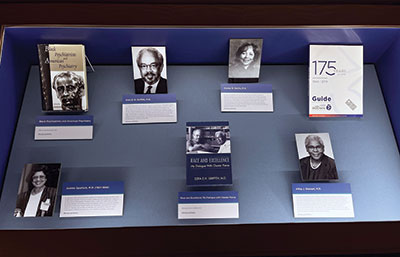Library Exhibit Celebrates APA’s Black Psychiatrists
Abstract
Among the psychiatrists featured are those who played a role in the Black Caucus resolutions presented to APA’s Board of Trustees in 1969. The exhibit will be open for in-person viewing until August.
A new exhibit in the APA Foundation’s (APAF) Melvin Sabshin, M.D. Library & Archives honors the contributions that Black psychiatrists have made to APA’s history.

The exhibit in the Melvin Sabshin, M.D. Library & Archives features prominent figures in APA’s history, including (clockwise from top) Ezra Griffith, M.D., Donna Norris, M.D., Altha Stewart, M.D., and Jeanne Spurlock, M.D.
The exhibit, titled “Voices of Progress: A Historical Journey of Black Psychiatrists in the APA,” highlights the Black psychiatrists who played a role in the Black Caucus Resolution presented to APA’s Board of Trustees at the 1969 Annual Meeting in Miami Beach, Fla. It also features the history of the Black Psychiatrists of America (BPA), APA’s Caucus of Black Psychiatrists, and previous recipients of the Solomon Carter Fuller Award.
“It’s hugely important that we showcase this history because of the significant impact that Black psychiatrists have made to both APA and the field of psychiatry as a whole,” said Jonathan Shepherd, M.D., president of APA’s Caucus of Black Psychiatrists. “We need to make sure we are teaching history truthfully so that the workforce of the future know that they stand on the shoulders of people who worked and made sacrifices so they could be part of this organization.”
“Part of the role of the Melvin Sabshin, M.D. Library & Archives is to preserve and examine psychiatry’s history so we can reflect on and learn from our past,” said APAF Executive Director Rawle Andrews Jr., Esq. “Thank you to these physician psychiatrists who continue to move us toward mental health equity.”
The psychiatrists honored in the gallery were those who challenged APA to adopt progressive advocacy stances toward anti-discrimination policies, said Librarian and Archivist Deena Gorland, M.S.L.I.S.
At APA’s 1969 Annual Meeting, the Ad Hoc Committee of the BPA presented APA trustees with a list of demands. One result was the creation of the Minority Group Program Development Project. In 1974, it was replaced by the Office of Minority and National Affairs, and Jeanne Spurlock, M.D., was appointed director and APA deputy medical director. Spurlock, who is featured in the exhibit, spent 17 years with APA and championed workforce diversity in the field of psychiatry; she was presented with APA’s Solomon Carter Fuller Award in 1988. APAF established the Jeanne Spurlock Congressional Fellowship in honor of her work as a child and minority mental health advocate.
Other psychiatrists featured in the gallery include Solomon Carter Fuller, M.D., the first Black member of APA; Charles Prudhomme, M.D., APA’s first Black vice president; Chester Pierce, M.D., the founding national chair of the BPA; and Altha Stewart, M.D., APA’s first Black president.
“Our history should be celebrated,” Shepherd said. “We have dealt with many travesties and injustices, true, and yet we also have made significant positive contributions to the field and continue to have a seat at the table, and that should be celebrated.”
The exhibit features primary source documents such as the program book from the 1969 Annual Meeting and books such as Beyond Black and White by James Comer, M.D., one of the founding members of the BPA. APA members may visit the exhibit until August, and the virtual gallery is live indefinitely. ■
Resources
Members who wish to visit APA headquarters to view the exhibit should contact Deena Gorland at [email protected].



